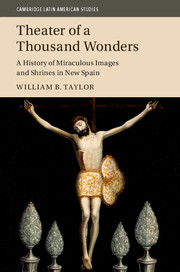Book contents
- Frontmatter
- Dedication
- Contents
- List of Figures
- List of Maps
- List of Tables
- Preface and Acknowledgments
- Archive Abbreviations
- Introduction
- Part I Bearings: Historical Patterns and Places of Image Shrines
- 1 Formative Developments, 1520s–1720s
- 2 Growth, Other Changes, and Continuities in the Late Colonial Period
- 3 Miraculous Images of Christ and the Virgin Mary
- 4 Advocations of the Virgin Mary in the Colonial Period
- Part II Soundings: Divine Presence, Place, and the Power of Things
- Conclusion
- Appendix 1 Colonial Image Shrines
- Appendix 2 When Shrines Began
- Appendix 3 Other Saints
- Index
1 - Formative Developments, 1520s–1720s
from Part I - Bearings: Historical Patterns and Places of Image Shrines
Published online by Cambridge University Press: 05 September 2016
- Frontmatter
- Dedication
- Contents
- List of Figures
- List of Maps
- List of Tables
- Preface and Acknowledgments
- Archive Abbreviations
- Introduction
- Part I Bearings: Historical Patterns and Places of Image Shrines
- 1 Formative Developments, 1520s–1720s
- 2 Growth, Other Changes, and Continuities in the Late Colonial Period
- 3 Miraculous Images of Christ and the Virgin Mary
- 4 Advocations of the Virgin Mary in the Colonial Period
- Part II Soundings: Divine Presence, Place, and the Power of Things
- Conclusion
- Appendix 1 Colonial Image Shrines
- Appendix 2 When Shrines Began
- Appendix 3 Other Saints
- Index
Summary
Catholic Christianity and its imagery broke in on Mesoamerica suddenly in the 1520s and has been a pivot point of living and dying there ever since. But there is no simple story of an early formative stage and late decline in the history of Christian image shrines in New Spain. They began in the sixteenth century, haltingly; and with many shrines eventually scattered over a vast, broken terrain, local histories of Christian practice were bound to depart from models and prescriptions in Rome, Madrid, Mexico City, or less remote capitals and style centers. The weight of the European past and present in the development of Christianity and religious practices in New Spain was great, and diffusion from Catholic Europe lends some coherence to the history of image shrines, whether following European trends or working against them. But Europe, too, is a moving target, neither uniform nor fixed and finished in its religious culture. What, then, can be said with some confidence about the impact of European beliefs and practices on the development of those shrines? What changed where and when?
This chapter tracks their early development, during the sixteenth and seventeenth centuries. Most image shrines and the full range of their distinguishing features took shape later than might be expected, mainly during a “long” seventeenth century from the 1580s to the 1720s that amounted to the formative period. Chapter 2 continues into the eighteenth century, suggesting that the late colonial period was less a time of decline for shrines and enchantment than one of consolidation and growth. (See Map 1.1 for the image shrines discussed in the text.) The substantial, if gradual, developments in the seventeenth and eighteenth centuries lead to consideration of long-term continuities from precolonial times on in the second part of Chapter 2, and the leading role of Marian and Christocentric shrines and images in Chapters 3 and 4.
Sixteenth-Century Beginnings: European Roots and Branches
Scholarship about nearly all aspects of religion in New Spain has centered on the sixteenth century rather than taking in the full sweep of the colonial period. Lines of interpretation have varied but the effect has been to treat the early years of colonization as formative for religion in the same ways that colonial institutions, imperial practices, economic activities, and labor systems were largely established then.
- Type
- Chapter
- Information
- Theater of a Thousand WondersA History of Miraculous Images and Shrines in New Spain, pp. 35 - 94Publisher: Cambridge University PressPrint publication year: 2016

